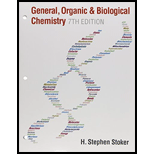
(a)
Interpretation:
Physical state at room temperature for succinic acid has to be given.
Concept Introduction:
Physical property of
(b)
Interpretation:
Physical state at room temperature for octanoic acid has to be given.
Concept Introduction:
Physical property of carboxylic acid is decided by the carbon chain and the functional group. Carboxylic acids are highly polar, as the carboxyl group is more polar. Due to this polar nature, the melting and boiling point are very high. Monocarboxylic acids that are unsubstituted which contains up to nine carbon atoms are present in liquid state. They have very sharp odor. Monocarboxylic acids that have more than ten carbon atoms in an unbranched fashion are waxy solids. They do not have any odor because of low volatility. Similar to this, dicarboxylic acids and aromatic carboxylic acids do not have any odor and they are solids.
(c)
Interpretation:
Physical state at room temperature for pentanoic acid has to be given.
Concept Introduction:
Physical property of carboxylic acid is decided by the carbon chain and the functional group. Carboxylic acids are highly polar, as the carboxyl group is more polar. Due to this polar nature, the melting and boiling point are very high. Monocarboxylic acids that are unsubstituted which contains up to nine carbon atoms are present in liquid state. They have very sharp odor. Monocarboxylic acids that have more than ten carbon atoms in an unbranched fashion are waxy solids. They do not have any odor because of low volatility. Similar to this, dicarboxylic acids and aromatic carboxylic acids do not have any odor and they are solids.
(d)
Interpretation:
Physical state at room temperature for p-chlorobenzoic acid has to be given.
Concept Introduction:
Physical property of carboxylic acid is decided by the carbon chain and the functional group. Carboxylic acids are highly polar, as the carboxyl group is more polar. Due to this polar nature, the melting and boiling point are very high. Monocarboxylic acids that are unsubstituted which contains up to nine carbon atoms are present in liquid state. They have very sharp odor. Monocarboxylic acids that have more than ten carbon atoms in an unbranched fashion are waxy solids. They do not have any odor because of low volatility. Similar to this, dicarboxylic acids and aromatic carboxylic acids do not have any odor and they are solids.
Want to see the full answer?
Check out a sample textbook solution
Chapter 16 Solutions
Bundle: General, Organic, and Biological Chemistry, 7th + OWLv2 Quick Prep for General Chemistry, 4 terms (24 months) Printed Access Card
- What is the physical state (solid, liquid, or gas) of each of the following carboxylic acids at room temperature? a. Oxalic acid b. Decanoic acid c. Hexanoic acid d. Benzoic acid Classify the two carboxylic acids in each of the following pairs as (A) both dicarboxylic acids, (B) both monocarboxylic acids, or (C) one dicarboxylic and one monocarboxylic acid. 1. Glutaric acid and valeric acid 2. Adipic acid and oxalic acid 3. Caproic acid and formic acid 4. Succinic acid and malonic acid Each of the following acids contains an additional type of functional group besides the carboxyl group. For each acid, specify the non-carboxyl functional group present. 9. Acrylic acid 10. Lactic acid 11. Maleic acid 12. Glycolic acid 13. Fumaric acid 14. Pyruvic acid 15. Malic acid 16. Tartaric acid What type of chemical reaction does carboxylic acid undergo in the following situations? 17. synthesis of methyl salicylate 18. reaction with a strong alkali 19. occurs in aqueous solution 21. release of…arrow_forwardThe hydrolysis of an amide in acidic conditions forms A. a carboxylate salt and an alcohol B. a carboxylate salt and an amine C. an alcohol and an amine salt (an ammonium ion) D. a carboxylic acid and an amine salt (an ammonium ion)arrow_forwardWhat is porphyrin ?arrow_forward
- The carboxylic acid compound is widely used as an antifungal agent a. oxalic b. benzoic c. salicylic d. aceticarrow_forwardWhich of the following compounds will NOT test positive in a hydroxamic test? a. butanoic acid b. butanoyl chloride c. butyl ethanoate d. butanoic acid anhydridearrow_forwardAcid Alcohol Odor Structure salicylic acid methanol wintergreen ? anthranilic acid methanol Grape ?arrow_forward
- Briefly explain the following. Why hydrolysis of esters produce a sour smell in some reactions? Why are alcohol solutions used in hydroxamic test for esters?arrow_forwardDefine physical properties of carboxylic acid derivatives ?arrow_forwardWhat is the name of the major product formed during the reaction between berzoyl chloride and phenol? a. phenyl benzoate b. benzyl ester C. cyclopentanoate d. benzyl phenoate e. benzenecarboxylic acid O a O b O c earrow_forward
- The IUPAC name for a carboxylic acid with three carbons in a straight chain would be A. propanoic acid B. ethylmethanoic acid C. propanalic acidarrow_forwardWhat are the differences between the low carbon-containing carboxylic acid and the high carbon-containing carboxylic acid?arrow_forward17. Which functional groups are in the following molecule of aspirin? HO, a benzene ring, an ester, a ketone, and an alcohol b. a benzene ring, two ketones, an ether, and an alcohol a benzene ring, a carboxylic acid, an ether, and a ketone d. a benzene ring, a carboxylic acid, and an ester a. c.arrow_forward
 Chemistry for Today: General, Organic, and Bioche...ChemistryISBN:9781305960060Author:Spencer L. Seager, Michael R. Slabaugh, Maren S. HansenPublisher:Cengage Learning
Chemistry for Today: General, Organic, and Bioche...ChemistryISBN:9781305960060Author:Spencer L. Seager, Michael R. Slabaugh, Maren S. HansenPublisher:Cengage Learning World of Chemistry, 3rd editionChemistryISBN:9781133109655Author:Steven S. Zumdahl, Susan L. Zumdahl, Donald J. DeCostePublisher:Brooks / Cole / Cengage Learning
World of Chemistry, 3rd editionChemistryISBN:9781133109655Author:Steven S. Zumdahl, Susan L. Zumdahl, Donald J. DeCostePublisher:Brooks / Cole / Cengage Learning General, Organic, and Biological ChemistryChemistryISBN:9781285853918Author:H. Stephen StokerPublisher:Cengage Learning
General, Organic, and Biological ChemistryChemistryISBN:9781285853918Author:H. Stephen StokerPublisher:Cengage Learning Organic And Biological ChemistryChemistryISBN:9781305081079Author:STOKER, H. Stephen (howard Stephen)Publisher:Cengage Learning,
Organic And Biological ChemistryChemistryISBN:9781305081079Author:STOKER, H. Stephen (howard Stephen)Publisher:Cengage Learning,



